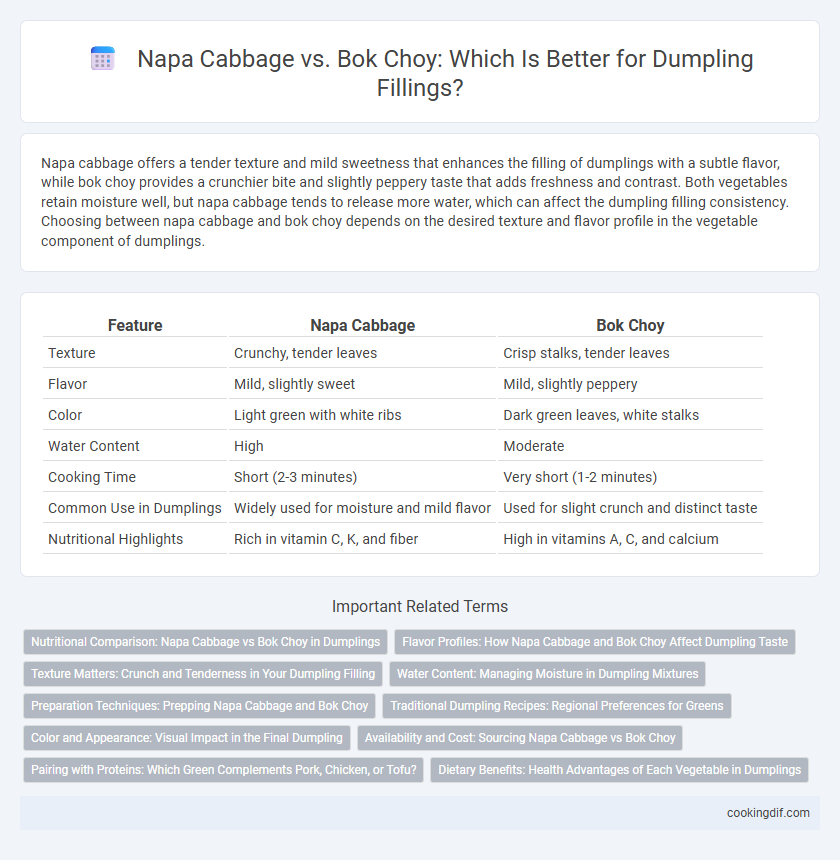Napa cabbage offers a tender texture and mild sweetness that enhances the filling of dumplings with a subtle flavor, while bok choy provides a crunchier bite and slightly peppery taste that adds freshness and contrast. Both vegetables retain moisture well, but napa cabbage tends to release more water, which can affect the dumpling filling consistency. Choosing between napa cabbage and bok choy depends on the desired texture and flavor profile in the vegetable component of dumplings.
Table of Comparison
| Feature | Napa Cabbage | Bok Choy |
|---|---|---|
| Texture | Crunchy, tender leaves | Crisp stalks, tender leaves |
| Flavor | Mild, slightly sweet | Mild, slightly peppery |
| Color | Light green with white ribs | Dark green leaves, white stalks |
| Water Content | High | Moderate |
| Cooking Time | Short (2-3 minutes) | Very short (1-2 minutes) |
| Common Use in Dumplings | Widely used for moisture and mild flavor | Used for slight crunch and distinct taste |
| Nutritional Highlights | Rich in vitamin C, K, and fiber | High in vitamins A, C, and calcium |
Nutritional Comparison: Napa Cabbage vs Bok Choy in Dumplings
Napa cabbage and bok choy both provide essential nutrients for dumplings, with napa cabbage offering higher fiber content and vitamin C, while bok choy excels in calcium and vitamin A. Bok choy contains more antioxidants and folate, supporting immune health, whereas napa cabbage features greater potassium levels, aiding in blood pressure regulation. Choosing between napa cabbage and bok choy depends on desired nutritional benefits, with both vegetables enhancing dumplings through unique vitamin and mineral profiles.
Flavor Profiles: How Napa Cabbage and Bok Choy Affect Dumpling Taste
Napa cabbage offers a mild, slightly sweet flavor with a tender texture that blends smoothly into dumpling fillings, enhancing juiciness without overpowering other ingredients. Bok choy provides a more pronounced, slightly peppery taste with a crispier bite, adding a fresh, vibrant contrast that elevates the overall dumpling experience. The choice between Napa cabbage and bok choy significantly influences the dumpling's flavor complexity and texture balance, tailoring it to either a gentler or more robust vegetable profile.
Texture Matters: Crunch and Tenderness in Your Dumpling Filling
Napa cabbage offers a tender, slightly crunchy texture that softens beautifully when cooked, making it ideal for dumpling fillings that require a delicate bite. Bok choy provides a crisp, fresh crunch with a mild bitterness, adding a vibrant contrast to the soft dumpling wrapper. Choosing between Napa cabbage and bok choy largely depends on whether you prefer a smoother, melt-in-your-mouth filling or a more defined crunch that enhances textural variety.
Water Content: Managing Moisture in Dumpling Mixtures
Napa cabbage contains about 95% water, making it prone to releasing excess moisture that can lead to soggy dumpling fillings. Bok choy has a slightly lower water content, around 93%, offering better moisture control and firmer texture in dumpling mixtures. Managing water content is crucial; squeezing out excess liquid from Napa cabbage or choosing bok choy helps maintain the ideal filling consistency and prevents dumpling wrappers from becoming soggy.
Preparation Techniques: Prepping Napa Cabbage and Bok Choy
Napa cabbage requires thorough washing to remove dirt between its crinkled leaves, followed by blanching or salting to soften its texture and reduce bitterness in dumpling fillings. Bok choy preparation involves trimming the base, washing each leaf meticulously, and often blanching briefly to preserve its crunchy texture and mild flavor. Both vegetables should be finely chopped to ensure even distribution and optimal moisture control in dumpling mixtures.
Traditional Dumpling Recipes: Regional Preferences for Greens
Traditional dumpling recipes showcase regional preferences for greens, with Napa cabbage favored in Northern Chinese styles for its tender texture and subtle sweetness that complements pork fillings. Bok choy is more common in Southern variations, prized for its crisp stalks and slightly peppery flavor that adds a fresh contrast. Both vegetables bring distinct qualities that influence the dumpling's overall taste and texture, reflecting local agricultural practices and culinary traditions.
Color and Appearance: Visual Impact in the Final Dumpling
Napa cabbage offers a pale green and creamy white color palette, giving dumplings a subtle, elegant appearance with delicate texture contrasts in the filling. Bok choy provides a more vibrant, deeper green with crisp white stems, creating a visually striking and fresh look that enhances the dumpling's overall presentation. The choice between Napa cabbage and Bok choy significantly influences the dumpling's visual appeal, with Napa cabbage contributing softness and Bok choy adding boldness in color.
Availability and Cost: Sourcing Napa Cabbage vs Bok Choy
Napa cabbage is widely available year-round in most supermarkets and tends to be more affordable due to its large-scale cultivation and longer shelf life. Bok choy, while also accessible, can be slightly pricier and less consistently stocked depending on the season and region, as it is more perishable. Choosing Napa cabbage for dumplings often reduces sourcing costs and ensures steady availability, making it a practical option for both home cooks and commercial kitchens.
Pairing with Proteins: Which Green Complements Pork, Chicken, or Tofu?
Napa cabbage offers a mild, slightly sweet flavor that pairs exceptionally well with pork, enhancing its richness without overpowering the meat. Bok choy's crisp texture and slightly peppery taste complement chicken by adding a fresh, light contrast that balances the protein's subtle flavors. Tofu's neutral profile benefits from both greens, but Napa cabbage absorbs marinades better, while bok choy adds a crunchy texture, making either choice versatile based on desired dumpling mouthfeel.
Dietary Benefits: Health Advantages of Each Vegetable in Dumplings
Napa cabbage in dumplings offers high fiber content and rich antioxidants like vitamin C and K, promoting digestion and immune support. Bok choy provides essential nutrients such as calcium, magnesium, and vitamin A, which contribute to bone health and eye protection. Both vegetables are low in calories and add vital micronutrients, enhancing the overall nutritional value of dumplings.
Napa cabbage vs Bok choy for vegetable component Infographic

 cookingdif.com
cookingdif.com